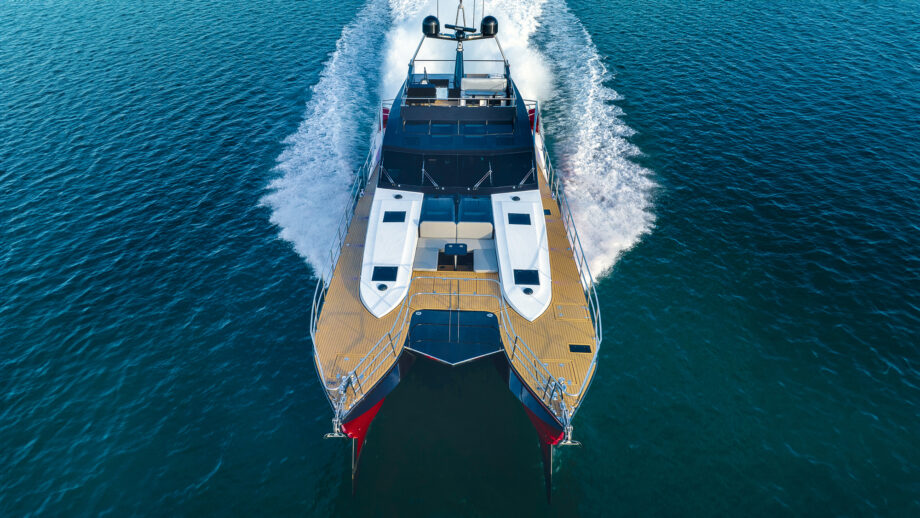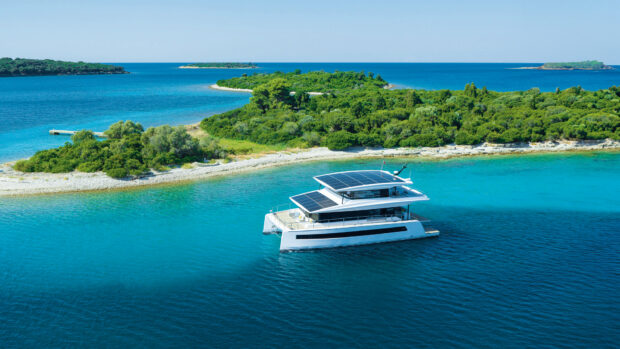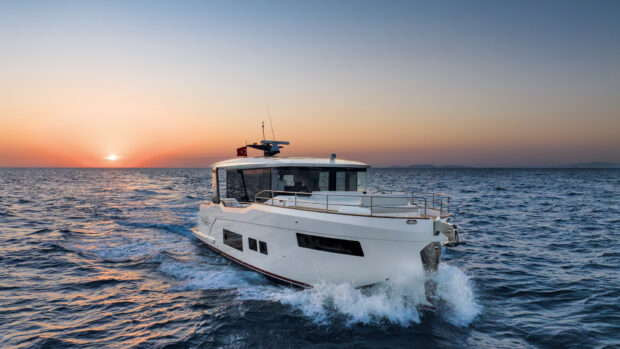Bored of tubby, overweight power cats? Safehaven Marine's Safehaven T-2000 Voyager is the ocean-munching superboat antidote you need. Alex Smith gets behind the wheel
 Watch the video
Watch the videoPlenty of modern boat builders claim to be committed to “adventure” and “exploration” – but while some are more closely aligned with blue-sky marketing narratives than outright performance, Safehaven’s credentials look absolutely impeccable.
Based in the south of Ireland, a stone’s throw from Cork, in a region where thousands of miles of open ocean bring huge, untamed seas to the doorstep, these guys build boats for all kinds of commercial concerns, from crew transfer vessels and search-and-rescue craft to patrol boats, pilot boats and military craft.
They’ve turned their hand to the leisure world on a couple of occasions too: firstly with a high-performance wave piercer known as the XSV17; and secondly with an even more capable cat/monohull hybrid known as the XSV20. As you might expect, these were both adapted from commercial underpinnings for leisure use but now, in the form of the new T-2000 Voyager, we have the first purpose-built leisure boat ever to emerge from the yard.
We’ve already seen videos of it playing happily among 30ft swells, whipped into violent, foaming crests by 60-knot storm force winds, so we know it performs precisely in line with the brand’s heritage. Here then, on a strangely bright and docile November morning, our purpose is not to do battle with the elements but to discover to what extent a boat of such uncompromising ability is able to fulfil its nominal function as a leisure boat.

The T-2000 Voyager is the first dedicated leisure boat ever to emerge from Safehaven Marine. Photo: Richard Langdon
Form and function
Let’s start with the styling because, while the profile is extraordinarily aggressive, that’s largely a consequence of the hull form. The beam is relatively narrow (for a catamaran), the wave-piercing entry is knife-like, the bridge deck is substantially raised and there’s a cutaway section at the leading edge of the foredeck.
The idea behind all of this is to reduce the vertical acceleration when you encounter a swell and to enable the seas to roll through the tunnel without the slam or projection of spray that so often accompanies less capable powercats. But just as these elements tread a line that satisfies both form and function, so the finer details of the Voyager follow suit.
Article continues below…

My Pick of the Top 10 Best Boats I Tested in 2024 – From Luxury Cruisers to Performance Powercats

Safehaven Barracuda SV11: Our most extreme boat test ever!
Editor Hugo conducts the most extreme boat test that the magazine has ever done, taking on 5m rollers over Daunt
The raised spear-like foredeck mouldings, for instance, are designed to generate extra space in the cabins but they are sculpted rather than flat, which adds plenty of extra dynamism to the aesthetic.
The exhausts are also housed in stylish geometric stainless steel funnels; and the aft swim platforms retract, giving you a better view of those lovely surface-piercing props while also helping minimise impacts when the boat pitches in big seas. Add to all of this a striking retro (almost ‘A-Team’) vibe, courtesy of tinted windows, curved steel-work and a lustrous crimson wrap and you have a boat that makes an extremely forthright style statement.

There’s a navigator’s position to starboard and companion seating to port. Photo: Richard Langdon
With that particular leisure boating box well and truly ticked then, it’s on to the external day spaces, which like pretty much any flybridge cruiser, amount to three. The first of them is the cockpit, which inhabits the full 20ft beam, with symmetrical access to the aft platforms and a central davit that enables you to mount your tender above the bridge deck for protection in lively conditions.
Ahead of that, the open deck is sparingly used on this demonstrator model, with just a port dinette and a modular starboard storage box with cushioned top and plenty of volume for covers, lines and fenders. It’s quite modest by the standards of the sector and it’s not convertible in any substantial way but the fact that Safehaven designs and builds everything at its own factory means you can arrange this aft space in any way you fancy.
As you head forward, past the low-level side gates and up a couple of steps to the foredeck, the test boat’s bow arrangement adopts a similar approach to that of the cockpit. You get a neatly sunken four-man dining zone in the centre of the deck that backs onto a tinted glass structure ahead of the screen.

The upper helm can be lifted up on hydraulics, enabling you to stand for a better view when coming alongside. Photo: Richard Langdon
You can top this glass with cushions for use as a sunbed and, thanks to a deep starboard locker, there’s plenty of space to store them. There’s an anchor on each forepeak too, both for symmetry and security, and on the port side, the deck hatch provides access to a single crew cabin with a wet room-style heads.
As for the flybridge, you wouldn’t expect it to be vast because a proper offshore design needs to keep the weight low and the windage minimal, but it’s large enough for a starboard helm, a port companion seat and a raised aft section that, on the test boat, is used for a liferaft.
In the interests of reduced drag, there’s no wind deflector up here and the helm is even more unusual, in that it can be raised on hydraulic struts, enabling you to stand up in comfort and come alongside with a proper view. But whether you sit or stand, the upward sweep of the bow and the downward sweep of the flybridge creates superb views.

The starboard galley is big enough (and custom-friendly enough) for proper liveaboard work. Photo: Richard Langdon
Internal arrangement
The internal saloon is divided from the cockpit by a rigid bulkhead with watertight fixtures for extra strength and rigidity. That does limit the interaction between inside and outside compared to most of the boats on the 70ft flybridge market but you still get fold-up windows on either side of the central door to bring the port dinette and starboard galley into closer union with the external deck.
If you spec the vacant space by the cockpit steps with a bar or an external service point, the integration is likely to feel just that little bit better – but again, the control Safehaven exercises over its design and production processes means you can have pretty much whatever you want.

In the 2-cabin + crew layout, the guest suite gets a bathroom beneath the companion seating. Photo: Richard Langdon
When you step inside, it’s clear that the seats at the port dinette have been deliberately elevated – firstly to improve forward views on a passage and secondly to compensate for the shallowness of the spaces beneath the deck with extra storage. That makes good sense because, while some powercats drop the bridge deck to such an extent that you can fit entire utility rooms beneath the floor, the Voyager’s sea manners have to take priority.
The L-shaped companion seating to port of the twin helm is also usefully raised and the starboard galley is a size and shape that again factors in plenty of flexibility in the way you can choose to spec it – but what really stands out in here is the starboard chart table.
It uses a huge digital screen that lifts up at the touch of a button and if paper charts are your preference, you can leave it horizontal and work on the glass screen instead. Either way, it comes with a rotating Grammer suspension seat as standard, plus a seatbelt for extra safety in the rough.

The guest double features a small dressing table, a TV and a third ‘letter-slot’ single berth inboard. Photo: Richard Langdon
As you would expect, the helm is equally high spec. It comes with four MFDs plus an armrest-mounted joystick and autopilot control for the skipper. The ergonomics are lovely and while you might suggest that the view is a shade hemmed in by the four-part screen, the fact that the Voyager uses smaller panels, reinforced mullions and inch-thick glass means you can shrug off 40-knot green water impacts without the slightest fear of failure.
And happily, the designers have again added fun to function with a glass viewing window in the saloon deck, enabling you to look down at the water and witness the hydrofoil doing its work.
As for the sleeping spaces, the use of narrow hulls, long engine rooms, extended shafts and 5,000L fuel tanks is good news for the boat’s performance but it does of course limit the amount of volume left over for the cabins. In the test boat, what we have is the owner’s cabin in the starboard hull, with a raised transverse double bed that extends inboard, between the bridge deck and the foredeck skylights.

The showy but pared back Art Deco-inspired style is a really gratifying match for the external design. Photo: Richard Langdon
On the port side, an ensuite guest double inhabits the space between the leading edge of the fuel tank and the aft bulkhead for the crew cabin. There’s a third ‘letter slot’ bed in here, which again extends inboard but for our money, the Voyager would be better off with the three-cabin layout, sacrificing the crew cabin for a pair of guest suites and a shared central bathroom. At a stroke, that would increase the permanent sleeping capacity to six while also providing a much more natural day heads for guests.
Peerless drive
Surface-piercing props tend to split opinion. While they’re designed to minimise drag by lifting half of the blades above the water’s surface, they can be slow and fussy when fully submerged – delaying your transition to the plane and adding awkwardness to low-speed manoeuvres.
Paradoxically though, Safehaven’s solution involves using ventilation ducts to channel air down to the props – and in practice, that sees us scooting up to speed without the slightest trouble.

The curious sunken lounge makes a handy work space and breakfast bar. Photo: Richard Langdon
As we push on, it’s also good to witness the scale and positivity of the hydrofoil’s impact. Increasing the revs from 1,250 to 1,500rpm sees the fin kick in with extra lift and efficiency, doubling our speed from 14 to 28 knots while also dropping our fuel flow by a third, from 12 litres per hour to just 8.
That ekes out the range to around 1,000 nautical miles with 20% in reserve. And thanks to the interaction between the slender hulls, the hydrofoil and the surface-piercing props, that range stays at 800 miles at 40 knots and 650 miles, even at the 52-knot top end.

The owner’s ensuite is lined with metallic vinyl for extra brightness. Photo: Richard Langdon
That’s mightily impressive on a 70ft flybridge-equipped cruiser but driving this thing is about much more than just efficiency. The fact that we have a relatively narrow beam and a hydrofoil means that when you throw it through a turn, it heels in like a high-performance monohull.
In spite of the thick mullions, the low-profile dash and central helm position mean that visibility is also surprisingly good and refinement is very serviceable too. While the extended engine bays risk creating intrusive noise in the saloon, sound readings in the low to mid 70s are much more cruise-friendly than you’d expect. In fact, it’s only when you get beyond 45 knots that the noise really escalates and the bulk of that comes not from the engines, but from water kicked up against the bridge deck by the hydrofoil.

The acute entry, pronounced spray rails and cutaway foredeck are all about offshore capability. Photo: Richard Langdon
Given the efficiency gains it delivers, that’s a compromise we’re very happy to make but again, as a serious offshore boat, we want more than that. We want to be able to really work the trim, particularly in a head sea – and again, it delivers.
Whether you choose to drop the drives or deploy the tabs, you can plough those bows with the utmost insistence, cleaving the swells as you go; and when you get back on the flat, you can lift the drives, throw out your rooster tail and eke out some extra pace.

Long, beautifully finished engine bays position the weight of the big MAN V12s well forward. Photo: Richard Langdon
At 52 knots, that pace is of course impressive for a boat of this scale but if you spec the top-rated 2,000hp MAN V12s, you’ll see speeds much closer to 60 knots. You could go further with your options too, trading the surface-piercing props for IPS drives, jets or conventional shafts. But given that you would be pegging yourself back to the low 40s and eroding your running efficiency into the bargain, that would seem like an odd choice to make.
Safehaven T-2000 Voyager specifications
LOA: 70ft 2in (21.4m)
BEAM: 20ft 6in (6.2m)
DRAFT: 6ft 3in (1.90m)
DISPLACEMENT: 32,500kg (light)
FUEL CAPACITY: 10,000 litres
WATER CAPACITY: 400 litres
ENGINES: Twin MAN V12 1550s
RCD: A
CONTACT: safehavenmarine.com
Safehaven T-2000 Voyager costs & options
From €2,900,000 ex VAT.
Test boat including the following options…
Air conditioning
Trim tabs
Underwater lighting
Watermaker
Chart table
 If you enjoyed this….
If you enjoyed this….
Motor Boat & Yachting is the world’s leading magazine for Motoryacht enthusiasts. Every month we have inspirational adventures and practical features to help you realise your sailing dreams, as well as tests and news of all the latest motorboats.
Plus you’ll get our quarterly Custom Yachting supplement where we share the last on offer in the superyacht world and at the luxury end of the market.
Build your knowledge with a subscription delivered to your door. See our latest offers and save at least 30% off the cover price.
Verdict
The T-2000 Voyager is not the obvious choice of cruising boat. Volume is nowhere near as great as that of a more conventional 70ft flybridge cruiser – and given the critical importance of its offshore performance, that was only to be expected. But it remains quite an eye-opening leisure boat. After all, this is a 70ft flybridge-equipped long-distance cruiser that can bomb along at up to 60 knots and remain composed and comfortable in some alarming seas. It will treat you to a thousand-mile range and it will return twice the efficiency of a conventional 70ft flybridge cruiser at 30 to 40 knots. It also offers a delightful contrast to the great many modern powercats that prioritise volume over all things. Rather than forcing you to chug along at 9 knots with a look of fatalistic resignation on your face, the Voyager reacts to your fine tuning of the controls, delivering many of the same handling characteristics (and helming thrills) as a high-performance monohull. No, it won’t accommodate 20 people for a genteel soiree and it does need to ramp up the cleverness and convertibility of its furniture to make best use of the space it has. But if you only need to entertain 12 people and sleep eight, this first true leisure boat from Safehaven marine is an outrageously exciting piece of work.




 If you enjoyed this….
If you enjoyed this….





